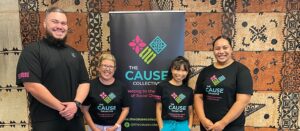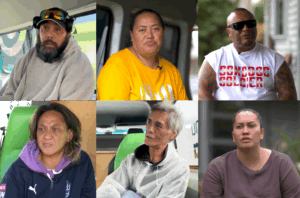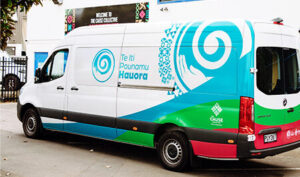Rebecca Fenn is New Zealand’s Nurse Practitioner of the Year whose inspiration to care for people came from her fascination with the “smell of hospitals” and “playing nurse dress up” as a child.
Kua roa tō te tangata e 55 ōna tau haerenga nō muri mai i tōna whakatipuranga i Plymouth, Ingarangi tae noa ki tāna taraiwa i tētahi pahi puta noa i Tāmaki ki te Tonga e rapua nei ngā tāngata tino rawakore, māuiui noki.
The 55-year-old has come a long way since her upbringing in Plymouth, England to driving a bus around South Auckland in search of some of the area’s most underserved and sickest people.
I hunuku mai ia rāua ko tōna hoa rangatira a Paul ki Tāmaki Makaurau mai i Rānana, i reira ia e whakangungu ana hei nēhi, i te 1998, ā, nō muri mai i taua wā kua hangāia e rāua tētahi whānau, ā, i riro i a rāua te whakaute nui rawa o ngā hapori Māori, Pasifika hoki, i Tāmaki ki te Tonga, i reira e mahi ana a Paul hei kaiako.
Her and husband Paul moved to Auckland from London, where she trained as a nurse, in 1998 and in that time they have built a whānau and earned huge respect from predominately Māori and Pacific communities in South Auckland where Paul also works, as a teacher.
“Ko tētahi o tā māua tamāhine e ako ana hei tapuhi whakawhānau, engari ko te tamāhine kē e rata ake ana ki te moana. Ka tino whakahē ia ki ngā hōhipera, nō reira kei te whakamahere ia kia whai i te ara kaipūtaiao mātai koiora moana,” hei tāna.
“One daughter is training to be a midwife, but the other one prefers the ocean. She can’t stand hospitals, so she is planning to become a marine animal scientist,” Fenn said.
“He āhuatanga pohewa tāku whiwhi i te toa. He hōnore nui tēnei, engari mōku ake ko te mea nui kē ko tōku whānau me āku hoa e mātakitaki nei ki tōku haerenga. E poho kererū ana ahau, ka kīia e au, āe kua tutuki ahau i tērā.”
“Getting the award has been super surreal. I feel really honoured by it but for me it’s about my family and very close friends who’ve watched my journey. I feel a little bit proud, it’s kind of like yeah; I did that.”
50 stitches but no GP
Ko tā Fenn mahi tuatahi i Aotearoa ko te mahi nēhi i te taiwhanga ohotata i te hohipera i Te Raki Paewhenua, i mua atu tērā i tōna wehenga ki te taiwhanga ohotata i te Hohipera o Middlemore, i reira e mahi ana ia mō ngā tau 10 tae noa ki tētahi āhuatanga i whakararua tāna moe.
Fenn’s first job in New Zealand was working as a nurse at North Shore Hospital ED, before heading to Middlemore Hospital ED where she worked for 10 years until one particular incident made her lose sleep.
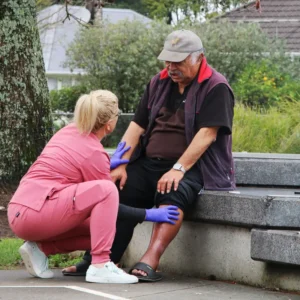
“I tētahi pō i tuitui ake ahau i tētāhi wahine i te taiwhanga ohotata. E matea ana ngā māwhitiwhiti e 50 i tōna waewae. I mua i tā mātou tuku i ngā tūroro me mōhio mātou ki tō rātou GP, engari karekau he GP.”
“One night I was at the ED stitching up a woman. She needed 50 stitches in her leg. Before we let patients go, we have to know who their GP is but she had no GP.
‘I was uncomfortable sending her out into the world knowing that she wasn’t going to get that nasty wound looked it. I think I lost sleep over that.’
“He GP tō te katoa o ngā tāngata i tuituia e au i neke atu i te 10 tau i mahia i te ED, engari kāhore tētahi tō tēnei wahine. Kāhore i te pai ki ahau tāku tuku i a ia ki te ao me te mōhio he kore haumanu tōna mō taua taotū kino. Ka raweketia te moe e tērā.
“Every person I stitched up in the 10-plus years I’ve worked in ED, had a GP but not her. I was uncomfortable sending her out into the world knowing that she wasn’t going to get that nasty wound looked it. I think I lost sleep over that.”
Nō konei ka pātaingia e Fenn mō tā tāna mahi whaihua tūturu, ā, me pehea noki tāna whakaaweawe i ērā “kāhore e taea te aweawe, karekau he GP”.
So it was here that Fenn started to question whether or not she was really making a difference and what could she do to “reach the unreachable, who didn’t have GPs”.
“Nō muri tata mai i taua tūroro, ka tūtaki ahau i tētahi wahine i tētahi kai hāhi, e mahi ana hei rata, ā, e hiahia ana ia hoki kia whai i tētahi ara tika ake mō ngā tāngata māuiui he kore he rata, e kore e pīrangi kia kite i tētahi rānei.”
“Not too long after that patient, I met a lady at a church dinner who was a GP and who, like me, was exploring how we can do health better for people who are sick and don’t have a GP or won’t go to see one.”
Serving the underserved
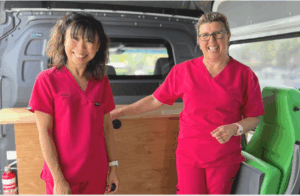
Nō muri mai i ētahi kai anō, e hangāia ana e te takirua ko Fenn rāua ko te rata arowhānui a Juliet Tay tētahi mahere kia puta rāua i ngā pakitara e whā o ā rāua mahi i tētahi hōhipera me tētahi pūtahi hauora hei whakatū i tētahi ratonga hauora e whakanekeneke ana mō te tuku atawhai ki ngā hapori rawakore, uaua te whai piringa noki i Tāmaki ki te Tonga, arā, ko rātou e hinga nei ki ngā tawhā pūnaha.
After a few more dinners, Fenn and general practice doctor Juliet Tay concocted a plan to leave the four walls of their jobs in a hospital and a medical centre to create not just a mobile healthcare service, but a lifeline for vulnerable and hard-to-reach communities in South Auckland who had slipped through the cracks of the system.
“Kua kīia e Juliet e angitu ai te kaupapa me whiwhi ahau i te tohu mātanga tapuhi, nō reira ka whakangungu ahau ki tērā. Ka kī ahau ki a ia, e mate ana tāna rapu ki tētahi pahi i whai i a ia ki tētahi PHO e mahia ana e ia i taua wā.
“Juliet said to me that for this to work, I needed to become a nurse practitioner, so I started training for that. I told her, she needed to get us a bus which she managed to do from the PHO she was working under at that time.
‘We were and still are both driven by the people who have been forgotten, who for whatever reason don’t trust or feel safe or can’t go to medical centres and GPs.’
Ko te mahi i tata mua i tā rāua aro ko te rapu ki tētahi rōpū hei whakaeaea, hei whakaruruhau i tā rāua ratonga.
The next step was for them to find a group to fund and act as umbrella to their service.
“Ka tūtaki ahau i a Riana Manuel nōna e mahi ana hei tumuaki o Te Aka Whai Ora kātahi anō ka whakatūria. He tapuhi ia nō reira e mōhio ana ia ki tā māua matawhānui, ā, ka tukuna te pūtea e hiahiatia ana kia mahi tonu i ngā marama e ono i te ihu o te 2023 hei orokohanga, he kōha kāmehameha tērā,” ka kī a Fenn.
“I went to see Riana Manuel who at that time was the chief executive of the newly set up Te Aka Whai Ora–Māori Health Authority. She was a nurse too, so understood our vision and gave us the funding we needed to operate for the first six months in early 2023, which I am still so very grateful for,” Fenn said.
